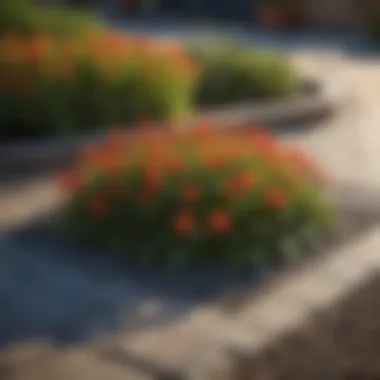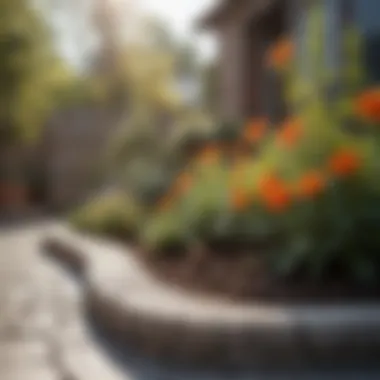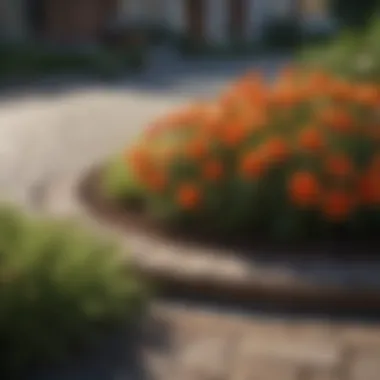Materials:
- Concrete pavers: 50 pieces of 12" x 12" pavers, 30 pieces of 6" x 6" pavers
- Paver adhesive: 2 gallons
- Gravel: 1 cubic yard
- Sand: 5 bags of coarse sand, 3 bags of fine sand
- Landscape fabric: 1 roll
- Edging stones: 20 pieces of 8" edging stones
- Tape measure
- Shovel
- Level
- Rubber mallet
- Wheelbarrow
DIY Steps:
- Measure and mark the area for the flower bed using a tape measure.
- Excavate the marked area to a depth of 6 inches using a shovel, ensuring the ground is level.
- Compact the soil and add a layer of gravel, leveling it with a rake.
- Lay down landscape fabric to prevent weed growth.
- Place edging stones around the perimeter and secure them using paver adhesive.
- Arrange the large pavers in the desired pattern within the bed.
- Fill the gaps with sand, making sure the pavers are level.
- Compact the pavers with a rubber mallet to set them in place.
Technical Aspects:
- Timing: Plan the project over a weekend for optimal focus and execution.
- Tools: Utilize a tape measure for precision, a shovel for excavation, and a level for accuracy.
- Techniques: Ensure proper compaction of soil and gravel for a stable base. Use a rubber mallet to evenly set the pavers.
DIY Project Process:


- Start by measuring and marking the area for the flower bed, following with excavation and soil preparation.
- Secure the perimeter with edging stones and carefully lay out the pavers in a visually appealing design.
- Fill the gaps with sand, compact the pavers, and make final adjustments for a polished look.
- Troubleshooting Tips: If pavers are uneven, carefully lift and readjust them. To prevent weed growth, monitor and replace landscape fabric if damaged.
Introduction


Gardens are like a canvas waiting to be painted, a space where beauty meets functionality. In the realm of gardening, the concept of a paver flower bed stands out as a hallmark of elegance and organization. It is not merely about placing pavers; rather, it is a meticulous art form that enhances the overall allure of your outdoor space. This comprehensive guide delves into the realm of paver flower beds, unraveling the intricacies involved in planning, executing, and maintaining a botanical masterpiece within your garden.
Benefits of a Paver Flower Bed


Enhancing Curb Appeal
The mesmerizing appeal of a paver flower bed cannot be overstated. By carefully integrating pavers with colorful blooms, you create a visual spectacle that instantly elevates the aesthetics of your garden. The symphony of textures and colors draws the eye and offers a warm welcome to visitors, leaving a lasting impression long after they depart.
Creating Defined Garden Spaces
One of the key advantages of a paver flower bed is the ability to segment and define various garden areas. Through thoughtful planning and layout design, you can carve out distinct pockets of greenery, transforming a sprawling landscape into a structured oasis. This segmentation adds a sense of order and sophistication to your garden, enhancing its overall appeal.
Reducing Weed Growth
Incorporating pavers into your flower bed not only adds visual appeal but also serves a practical purpose by minimizing weed growth. The pavers act as a barrier, inhibiting weed proliferation and reducing the need for frequent maintenance. This proactive approach to weed control ensures that your garden remains pristine and weed-free, allowing your plants to thrive without competition from unwanted intruders.
Benefits of a Paver Flower Bed
A paver flower bed offers numerous advantages that go beyond mere aesthetics. One of the key benefits is enhancing curb appeal, which plays a crucial role in creating a welcoming and visually appealing exterior for your home. By incorporating a paver flower bed, you can significantly elevate the overall look of your garden and make a lasting first impression on visitors. Moreover, these flower beds help in defining garden spaces, providing a structured and organized layout to your outdoor area. This not only adds sophistication but also contributes to increased functionality.
In addition, paver flower beds act as a barrier against weed growth, thereby reducing the need for frequent weeding and maintenance. The pavers create a boundary that restricts the spread of weeds, keeping your garden neat and well-maintained with minimal effort. This, in turn, saves you time and energy that would otherwise be spent on tedious weeding tasks. Overall, investing in a paver flower bed brings a host of benefits that enhance both the aesthetics and practicality of your outdoor space.
Enhancing Curb Appeal
Enhancing curb appeal is a critical aspect of creating a visually pleasing and welcoming outdoor environment. A paver flower bed plays a significant role in enhancing curb appeal by adding a touch of elegance and charm to your garden. The structured layout and carefully chosen plants contribute to creating a focal point that draws attention and creates a sense of harmony.
Furthermore, a well-designed paver flower bed complements the architectural style of your home, blending seamlessly with the overall design aesthetic. The use of pavers provides a clean and polished look, adding a touch of sophistication to your exterior space. By enhancing curb appeal with a paver flower bed, you can improve the overall visual impact of your property and create a warm and inviting atmosphere for both residents and guests.
Creating Defined Garden Spaces
Creating defined garden spaces is essential for organizing your outdoor area and maximizing its potential. A paver flower bed helps in defining specific zones within your garden, allowing you to create separate areas for different purposes such as planting, relaxation, or entertainment. This division of spaces adds structure and coherence to your outdoor environment, ensuring that each area serves its intended function effectively.
Moreover, by incorporating a paver flower bed, you can establish clear boundaries between different elements in your garden, such as flower beds, pathways, and seating areas. This not only improves the visual flow but also enhances the overall design of your outdoor space. By creating defined garden spaces with a paver flower bed, you can optimize the use of your garden and make the most of every corner, transforming it into a functional and aesthetically pleasing retreat.
Reducing Weed Growth
Weed growth can be a persistent problem in maintaining a garden, requiring constant attention and effort. A paver flower bed offers an effective solution to this issue by reducing weed growth and minimizing the need for frequent weeding. The solid barrier created by the pavers prevents weeds from spreading, keeping your garden looking pristine and well-maintained.
The use of pavers in a flower bed not only controls weed growth but also improves the overall health of your plants by reducing competition for nutrients and resources. This leads to healthier and more robust plant growth, enhancing the beauty and vitality of your garden. By significantly decreasing the presence of weeds, a paver flower bed allows you to focus on enjoying your outdoor space rather than constantly battling unwanted intruders, creating a low-maintenance and visually appealing garden environment.
Planning Your Paver Flower Bed
In the realm of garden enhancement, planning your paver flower bed is a crucial facet that sets the foundation for a visually captivating outdoor space. The meticulous process of planning involves carefully considering various elements to ensure the successful execution of your project. One of the primary benefits of planning your paver flower bed is the opportunity it provides to envision and customize your garden space according to your preferences and style. By thoroughly planning the layout and design, you can harmonize your paver flower bed with the existing landscape, elevating the overall aesthetic appeal of your garden.
Choosing the Right Location
When selecting the ideal location for your paver flower bed, several factors must be taken into account to optimize its impact and functionality. Sunlight exposure is a critical consideration, as most flowering plants require adequate sunlight to thrive. Assess the sunlight patterns in your garden throughout the day to identify spots with optimal sunlight for your flowers. Additionally, consider accessibility and visibility aspects to ensure that your paver flower bed is conveniently located and serves as a focal point in your garden landscape.
Selecting Suitable Paver Materials
The selection of paver materials plays a significant role in the durability and aesthetic appeal of your flower bed. Different types of pavers, such as concrete, brick, or natural stone, offer distinct advantages in terms of appearance, longevity, and maintenance requirements. Evaluate the visual and functional aspects of each material to determine the most suitable option that complements your garden style and meets your preferences. Additionally, consider factors like budget, climate compatibility, and maintenance ease when choosing paver materials for your flower bed.
Designing the Layout
Designing the layout of your paver flower bed is a creative process that involves conceptualizing the arrangement of pavers and plants to achieve a balanced and visually pleasing composition. Take inspiration from different garden design styles and layouts to create a unique and harmonious arrangement for your flower bed. Consider aspects like symmetry, color coordination, and plant heights when designing the layout to create a cohesive and aesthetically pleasing garden feature. Remember to account for pathways, borders, and focal points to enhance the overall visual impact of your paver flower bed.
Preparation and Installation
When it comes to enhancing your garden with a paver flower bed, the stage of preparation and installation plays a crucial role in the seamless execution of this landscaping project. The proper preparation ensures a strong foundation for the pavers to be laid upon and promotes the longevity of your flower bed.
Site Preparation
Site preparation involves a series of essential steps to create an optimal environment for your paver flower bed. Clearing the area of any debris, weeds, or pre-existing vegetation is the initial task. This allows for a clean slate to work on and prevents any interference with the pavers' placement. Additionally, evaluating the soil quality and ensuring proper drainage are key considerations during site preparation. Adequate drainage helps prevent water accumulation, which could potentially damage the paver installation over time.
Installing the Pavers
The installation of pavers requires precision and attention to detail to achieve a polished outcome. Begin by laying a strong base material, such as crushed stone or sand, to create a stable foundation for the pavers. Carefully placing each paver in the desired pattern or design is a meticulous process that influences the overall aesthetic appeal of your flower bed. Utilizing a level to ensure uniformity and straight lines is essential for a professional-looking finish.
Adding Drainage
Proper drainage is essential for the health of your paver flower bed and surrounding garden. By incorporating drainage solutions during the installation phase, you can prevent waterlogging, flooding, and soil erosion. Installing perforated pipes or creating a slope that directs water away from the flower bed helps maintain the integrity of the pavers and promotes healthy plant growth. Effective drainage also limits the formation of puddles, which could attract pests or promote weed growth. Implementing drainage considerations enhances the longevity and visual appeal of your paver flower bed.
Planting in Your Paver Flower Bed
In the realm of enhancing your garden with a paver flower bed, planting the right flora plays a pivotal role. The process of selecting and situating plants is crucial not only for the aesthetics of the garden but also for its functionality. By carefully curating a selection of plants that complement each other and thrive in the chosen environment, you can create a harmonious and visually pleasing outdoor space. The choice of plants should be guided by factors such as sunlight exposure, soil type, and climate to ensure optimal growth and longevity.
Choosing the Right Plants
When embarking on the journey of cultivating a paver flower bed, one must approach the task of selecting plants with mindful consideration. It is essential to opt for greenery that not only aligns with your aesthetic preferences but also suits the specific conditions of your garden. Factors such as the plant's mature size, flowering season, maintenance requirements, and compatibility with other species should all be taken into account. By crafting a diverse plant palette that includes a mix of perennials, annuals, shrubs, and even ornamental grasses, you can establish a dynamic and vibrant garden that evolves throughout the seasons.
Creating a Balanced Composition
Achieving a harmonious and visually appealing composition in your paver flower bed involves a delicate balance of color, texture, height, and form. By strategically arranging plants of varying heights and foliage densities, you can create depth and dimension within the garden bed. Consider incorporating a mix of flowering plants, foliage plants, and architectural specimens to add interest and complexity to the landscape. Additionally, explore the interplay of colors – from vibrant hues to soothing neutrals – to evoke different moods and atmospheres within your outdoor space.
Maintaining Proper Plant Care
To ensure the long-term health and vitality of your paver flower bed, proper plant care is paramount. Regular maintenance tasks, such as watering, fertilizing, pruning, and pest control, are essential to promote healthy growth and blooming. Additionally, monitoring the soil condition, addressing any signs of disease or nutrient deficiencies, and providing adequate support for sprawling or climbing plants are integral aspects of plant care. By staying attentive to the needs of your plants and implementing proactive measures, you can cultivate a flourishing garden that brings joy and beauty year-round.
Maintaining Your Paver Flower Bed
In the realm of enhancing your garden with a paver flower bed, maintenance emerges as a critical facet that ensures the longevity and visual appeal of your outdoor space. Understanding the significance of maintaining your paver flower bed is vital to preserving the beauty and functionality of this landscaping feature.
Regular Cleaning and Weeding
Regular cleaning and weeding play a pivotal role in the upkeep of your paver flower bed. By regularly removing debris, fallen leaves, and dust, you can prevent the accumulation of dirt that might affect the aesthetics of the flower bed. Weeds, if left unchecked, can disrupt the growth of your plants and detract from the overall charm of the garden. Therefore, dedicating time to inspect and weed out unwanted plants is crucial for maintaining a pristine appearance.
Repairing Damages
Addressing damages promptly is crucial in ensuring the structural integrity of your paver flower bed. Whether it's a cracked paver, loose stones, or uneven surfaces, timely repairs can prevent further deterioration and maintain the functionality of the flower bed. Be sure to assess the damages, replace or fix any broken elements, and restore the bed to its original state to uphold its beauty and functionality.
Seasonal Care Tips
Seasonal care is essential for adapting your paver flower bed to the changing weather conditions. During the summer, hydration is key to sustaining plant life, while addressing drainage issues is crucial in the rainy season to prevent waterlogging. In winter, protective measures like covering delicate plants can shield them from frost. By understanding the unique needs of each season and adapting your care routine accordingly, you can ensure that your paver flower bed thrives throughout the year.
Conclusion
In the realm of garden landscaping, the conclusion of establishing a paver flower bed is not merely the endpoint of a project but the beginning of a harmonious blend of beauty and functionality. As the final touch to your outdoor masterpiece, the paver flower bed encapsulates the essence of meticulous planning, creative design, and diligent maintenance. It symbolizes a marriage of art and practicality, where aesthetics meet durability in a symphony of floral delights. The importance of this concluding step is paramount, as it fulfills the overarching goal of enhancing your garden's visual appeal while providing a structured framework for your plants to thrive.
When we reflect on the significance of the conclusion within this comprehensive guide, several key elements come to the forefront. Firstly, the conclusion signifies the culmination of thoughtful decision-making, from selecting the ideal location for your paver flower bed to choosing the perfect paver materials that complement your garden landscape. Every aspect of the planning process converges at this final stage, ensuring that your vision materializes seamlessly into reality.
Moreover, the conclusion heralds the transition from preparation and installation to the joy of witnessing the beauty of nature come to life within your garden oasis. It marks the moment when your carefully curated selection of plants finds their rightful place within the paver flower bed, creating a tapestry of colors, textures, and fragrances that elevate the ambiance of your outdoor sanctuary.
Furthermore, the conclusion instills a sense of pride and accomplishment, as you bask in the glory of a well-maintained garden space that exudes sophistication and charm. Regular cleaning, weeding, and seasonal care become integral components of preserving the allure of your paver flower bed, ensuring that it remains a focal point of admiration for years to come.
In essence, the conclusion is not merely a conclusion but a gateway to a world of botanical wonders and aesthetic delight. It serves as a testament to your dedication to creating a picturesque outdoor retreat that reflects your unique style and personality. Embrace the culmination of your efforts with a sense of satisfaction and fulfillment, knowing that your garden has been transformed into a timeless masterpiece that will enchant visitors and inspire admiration for generations to come.





